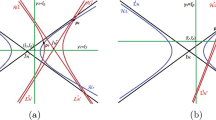Abstract
The paper presents a local study of bifurcations in a class of piecewise-smooth steady-state problems for which the regions of smooth behaviour permit analytical expressions. A system of piecewise-linear equations capturing the essential features of branching scenarios around points of non-smoothness is derived under the assumptions that (i) the points lie in the intersection of the boundaries of the regions where the gradients of the respective smooth selections have the full rank, (ii) there is no solution branch whose tangential direction is tangent to the boundary of any of the regions. The simplest cases of this system are studied in detail and the most probable branching scenarios are described. A criterion for detecting bifurcation points is proposed and a procedure for its realisation in the course of numerical continuation of solution curves is designed for large problems. Application of the general frame to discretised plane contact problems with Coulomb friction is explained. Simple as well as more realistic model examples of bifurcations are shown.




















Similar content being viewed by others
References
Alart P, Curnier A (1991) A mixed formulation for frictional contact problems prone to Newton like solution methods. Comput Methods Appl Mech Eng 92(3):353–375
Alexander JC (1978) The topological theory of an embedding method. In: Wacker H (ed) Continuation methods. Academic Press, New York, pp 37–68
Alexander JC, Li TY, Yorke JA (1983) Piecewise smooth homotopies. In: Eaves BC, Gould FJ, Peitgen HO, Todd MJ (eds) Homotopy methods and global convergence. Plenum Press, New York, pp 1–14
Allgower EL, Georg K (1997) Numerical path following. In: Handbook of numerical analysis, vol. 5. North-Holland, Amsterdam, pp 3–207
Beremlijski P, Haslinger J, Kočvara M, Outrata JV (2002) Shape optimization in contact problems with Coulomb friction. SIAM J Optim 13(2):561–587
di Bernardo M, Budd CJ, Champneys AR, Kowalczyk P (2008) Piecewise-smooth dynamical systems: theory and applications. In: Antman SS, Marsden JE, Sirovich L (eds) Applied mathematical sciences, vol 163. Springer, London
Björkman G (1992) Path following and critical points for contact problems. Comput Mech 10(3–4):231–246
Ciarlet PG (1988) Mathematical elasticity: three-dimensional elasticity. Studies in mathematics and its applications, vol I. Elsevier, North-Holland/Amsterdam
Conrad F, Herbin R, Mittelmann HD (1988) Approximation of obstacle problems by continuation methods. SIAM J Numer Anal 25(6):1409–1431
Conrad F, Issard-Roch F, Brauner CM, Nicolaenko B (1985) Nonlinear eigenvalue problems in elliptic variational inequalities: a local study. Commun Partial Differ Equ 10(2):151–190
Pinto da Costa A, Martins JAC (2003) The evolution and rate problems and the computation of all possible evolutions in quasi-static frictional contact. Comput Methods Appl Mech Eng 192(26–27):2791–2821
Pinto da Costa A, Martins JAC (2004) A numerical study on multiple rate solutions and onset of directional instability in quasi-static frictional contact problems. Comput Struct 82(17–19):1485–1494
Decker DW, Keller HB (1980) Multiple limit point bifurcation. J Math Anal Appl 75(2):417–430
Facchinei F, Pang JS (2003) Finite-dimensional variational inequalities and complementarity problems. In: Glynn PW, Robinson SM (eds) Springer series in operations research, vol 1. Springer, New York
Georg K (2001) Matrix-free numerical continuation and bifurcation. Numer Funct Anal Optim 22(3–4):303–320
Haslinger J, Janovský V, Kučera R (2013) Path-following the static contact problem with Coulomb friction. In: Brandts J, Korotov S, Křížek M, Šístek J, Vejchodský T (eds) Proceedings of the international conference Applications of mathematics 2013. Institute of Mathematics, Academy of Sciences of the Czech Republic, pp 104–116
Haslinger J, Janovský V, Ligurský T (2012) Qualitative analysis of solutions to discrete static contact problems with Coulomb friction. Comput Methods Appl Mech Eng 205–208:149–161
Hild P (2002) On finite element uniqueness studies for Coulomb’s frictional contact model. Int J Appl Math Comput Sci 12(1):41–50
Kanno Y, Martins JAC (2006) Arc-length method for frictional contact problems using mathematical programming with complementarity constraints. J Optim Theory Appl 131(1):89–113
Klarbring A (2002) Stability and critical points in large displacement frictionless contact problems. In: Martins JAC, Raous M (eds) Friction and instabilities, CISM courses and lectures, vol 457. Springer, Wien, pp 39–64
Ligurský T, Renard Y (2014) A continuation problem for computing solutions of discretised evolution problems with application to plane quasi-static contact problems with friction. Comput Methods Appl Mech Eng 280:222–262
Lundberg BN, Poore AB (1993) Numerical continuation and singularity detection methods for parametric nonlinear programming. SIAM J Optim 3(1):134–154
Miersemann E, Mittelmann HD (1989) Continuation for parametrized nonlinear variational inequalities. J Comput Appl Math 26(1–2):23–34
Paumier JC (1997) Bifurcations et méthodes numériques : applications aux problèmes elliptiques semi-linéaires, Recherches en Mathématiques Appliquées, vol 42. Masson, Paris
Poore AB, Tiahrt CA (1987) Bifurcation problems in nonlinear parametric programming. Math Progr 39:189–205
Renard Y, Pommier J GetFEM++. http://home.gna.org/getfem
Scholtes S (1994) Introduction to piecewise differentiable equations. Preprint No. 53/1994, Institut für Statistik und Mathematische Wirtschaftstheorie, Universität Karlsruhe
Schulz M, Pellegrino S (2000) Equilibrium paths of mechanical systems with unilateral constraints I. Theory. Proc R Soc Lond A 456(2001):2223–2242
Tiahrt CA, Poore AB (1990) A bifurcation analysis of the nonlinear parametric programming problem. Math Progr 47:117–141
Acknowledgments
The basis of this paper was laid down at a postdoctoral stay of T. Ligurský at INSA-Lyon funded by Manufacture Française des Pneumatiques Michelin. During further developments, T. Ligurský received support from the project “Support for building excellent research teams and inter-sectoral mobility at Palacký University in Olomouc II” (CZ.1.07/2.3.00/30.0041). Besides, both authors would like to thank anonymous referees for careful reading of the manuscript and their stimulating comments that have helped to improve the exposition.
Author information
Authors and Affiliations
Corresponding author
Rights and permissions
About this article
Cite this article
Ligurský, T., Renard, Y. Bifurcations in piecewise-smooth steady-state problems: abstract study and application to plane contact problems with friction. Comput Mech 56, 39–62 (2015). https://doi.org/10.1007/s00466-015-1154-1
Received:
Accepted:
Published:
Issue Date:
DOI: https://doi.org/10.1007/s00466-015-1154-1



